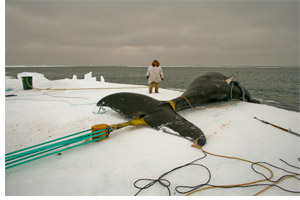 To make a trifecta of film posts for the day, I’ll point out Jonathan Harris’s The Whale Hunt. Properly speaking, this isn’t a film at all; rather, it’s a sequence of 3,214 photographs which Jonathan Harris took over a week’s trip to Alaska to observe a traditional whale hunt. Harris has date-stamped, captioned, and tagged (in three ways) each photograph. They appear in a Flash interface which displays the images in sequence: a very long slideshow. What’s interesting about Harris’s work – and which may merit his declaration that it’s “an experiment in human storytelling” is they way in which tags are used in the interface: if you click the whale that appears in the top center of each photographs, you can change the constraints on the sequence of photographs that you’re looking at. You can choose to see, for example, only photographs taken in Barrow, Alaska; only photographs featuring the first whale killed; only photographs that show children. Or you can choose a mixture of qualifications. One particularly interesting qualifier is the use of “cadence”: you can choose to see pictures that were taken close together in time – presumably when more interesting things were happening – or further apart – when, for example, the narrator is sleeping and has the camera set up to automatically photograph every five minutes.
To make a trifecta of film posts for the day, I’ll point out Jonathan Harris’s The Whale Hunt. Properly speaking, this isn’t a film at all; rather, it’s a sequence of 3,214 photographs which Jonathan Harris took over a week’s trip to Alaska to observe a traditional whale hunt. Harris has date-stamped, captioned, and tagged (in three ways) each photograph. They appear in a Flash interface which displays the images in sequence: a very long slideshow. What’s interesting about Harris’s work – and which may merit his declaration that it’s “an experiment in human storytelling” is they way in which tags are used in the interface: if you click the whale that appears in the top center of each photographs, you can change the constraints on the sequence of photographs that you’re looking at. You can choose to see, for example, only photographs taken in Barrow, Alaska; only photographs featuring the first whale killed; only photographs that show children. Or you can choose a mixture of qualifications. One particularly interesting qualifier is the use of “cadence”: you can choose to see pictures that were taken close together in time – presumably when more interesting things were happening – or further apart – when, for example, the narrator is sleeping and has the camera set up to automatically photograph every five minutes.
My sense in playing with it for a bit is that using constraint in this manner isn’t a tremendously compelling method of storytelling. It is, however, a powerful way of drilling into an archive to see exactly what you want to see.
